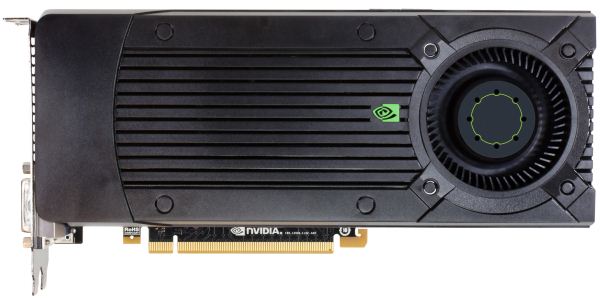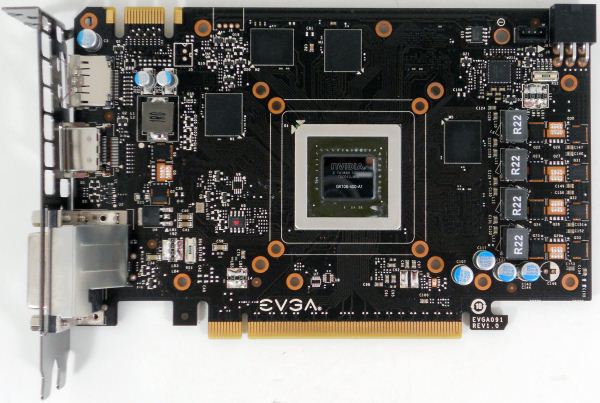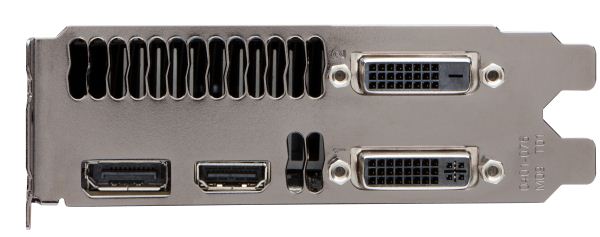The NVIDIA GeForce GTX 660 Review: GK106 Fills Out The Kepler Family
by Ryan Smith on September 13, 2012 9:00 AM ESTMeet The GeForce GTX 660
For virtual launches it’s often difficult for us to acquire reference clocked cards since NVIDIA doesn’t directly sample the press with reference cards, and today’s launch of the GeForce GTX 660 launch is one of those times. The problem stems from the fact that NVIDIA’s partners are hesitant to offer reference clocked cards to the press since they don’t want to lose to factory overclocked cards in benchmarks, which is an odd (but reasonable) concern.
For today’s launch we were able to get a reference clocked card, but in order to do so we had to agree not to show the card or name the partner who supplied the card. As it turns out this isn’t a big deal since the card we received is for all practical purposes identical to NVIDIA’s reference GTX 660, which NVIDIA has supplied pictures of. So let’s take a look at the “reference” GTX 660.
The reference GTX 660 is in many ways identical to the GTX 670, which comes as no great surprise given the similar size of their PCBs, which in turn allows NVIDIA to reuse the same cooler with little modification. Like the GTX 670, the reference GTX 660 is 9.5” long, with the PCB itself composing just 6.75” of that length while the blower and its housing composes the rest. The size of retail cards will vary between these two lengths as partners like EVGA will be implementing their own blowers similar to NVIDIA’s, while other partners like Zotac will be using open air coolers not much larger than the reference PCB itself.
Breaking open one of our factory overclocked GTX 660 (specifically, our EVGA 660 SC using the NV reference PCB), we can see that while the GTX 670 and GTX 660 are superficially similar on the outside, the PCB itself is quite different. The biggest change here is that while the 670 PCB made the unusual move of putting the VRM circuitry towards the front of the card, the GTX 660 PCB once more puts it on the far side. With the GTX 670 this was a design choice to get the GTX 670 PCB down to 6.75”, whereas with the GTX 660 it requires so little VRM circuitry in the first place that it’s no longer necessary to put that circuitry at the front of the card to find the necessary space.
Looking at the GK106 GPU itself, we can see that not only is the GPU smaller than GK104, but the entire GPU package itself has been reduced in size. Meanwhile, not that it has any functional difference, but GK106 is a bit more rectangular than GK104.
Moving on to the GTX 660’s RAM, we find something quite interesting. Up until now NVIDIA and their partners have regularly used Hynix 6GHz GDDR5 memory modules, with that specific RAM showing up on every GTX 680, GTX 670, and GTX 660 Ti we’ve tested. The GTX 660 meanwhile is the very first card we’ve seen that’s equipped with Samsung’s 6GHz GDDR5 memory modules, marking the first time we’ve seen non-Hynix memory on a GeForce GTX 600 card. Truth be told, though it has no technical implications we’ve seen so many Hynix equipped cards from both AMD and NVIDIA that it’s refreshing to see that there is in fact more than one GDDR5 supplier in the marketplace.
For the 2GB GTX 660, NVIDIA has outfit the card with 8 2Gb memory modules, 4 on the front and 4 on the rear. Oddly enough there aren’t any vacant RAM pads on the 2GB reference PCB, so it’s not entirely clear what partners are doing for their 3GB cards; presumably there’s a second reference PCB specifically built to house the 12 memory modules needed for 3GB cards.
Elsewhere we can find the GTX 660’s sole PCIe power socket on the rear of the card, responsible for supplying the other 75W the card needs. As for the front of the card, here we can find the card’s one SLI connector, which like previous generation mainstream video cards supports up to 2-way SLI.
Finally, looking at display connectivity we once more see the return of NVIDIA’s standard GTX 600 series display configuration. The reference GTX 660 is equipped with 1 DL-DVI-D port, 1 DL-DVI-I port, 1 full size HDMI 1.4 port, and 1 full size DisplayPort 1.2. Like GK104 and GK107, GK106 can drive up to 4 displays, meaning all 4 ports can be put into use simultaneously.














147 Comments
View All Comments
MySchizoBuddy - Friday, September 14, 2012 - link
If i'm a new buyer buying the older 560 at a reduced cost both be a better buy correct?Fiercé - Thursday, September 13, 2012 - link
While I may be in the minority, I actually check the "The Test" page of every GPU review in order to see which driver version is being used to test the hardware, as well as to get a quick mental list of 2 or 3 GPUs to watch out for in the FPS comparisons.Due to this I've noticed for this GPU review many cards are listed that don't appear anywhere in the benchmarks:
-AMD Radeon HD 6970
-AMD Radeon HD 7950B (explicitly stated over a non-B)
-AMD Radeon HD 7970
-NVIDIA GeForce GTX 570
-NVIDIA GeForce GTX 670
(Excepting all the GTX 660 Ti that of course can't be re-tested in time for a launch review, but might be useful as a "factory overclocked options" list for a reader looking at base 660 Ti performance.)
Ryan Smith - Thursday, September 13, 2012 - link
Thanks for the heads up. I had copied that out of the GTX 660 Ti article and had not yet edited it. It has been fixed.Fiercé - Thursday, September 13, 2012 - link
Cheers.Jamahl - Thursday, September 13, 2012 - link
That has the 660 faster than the 7870. Most reputable sites have the card squarely in-between the Pitcairns.Rick83 - Thursday, September 13, 2012 - link
It appears to me, that we should be glad, that the jump in performance is that low, as finally it seems the power wars of the last generation, when cards were dumping 200 Watts and more into your case, even when they were just higher mid-end cards, are over.Now of course that means we get slightly less of a performance boost, but at least power consumption of this card is below the level of a GTX260. That is important, as the 560Ti was relatively quite power hungry, especially once the wick on them was turned up a bit, which was being done quite liberally.
While the Performance/Dollar metric isn't that great, the performance/(dollar*power) is probably much better than last gen.
n9ntje - Thursday, September 13, 2012 - link
As everyone said it, nVidia is again late to the party. However, both (amd and nV) haven't done anything to improve the price/performance. First the $100 price range, now the 200?I'm sorry but since I bought my HD5750 almost 3 years(!) ago for 100 bucks. I dont get much more performance with a similair priced card. Now they are doing it the same to the 200 dollar cards..
CeriseCogburn - Thursday, November 29, 2012 - link
Welcome to the new socialist economy and 4 more years of it.Computer prices rise in the new socialist economy.
LOL
It's great, maybe AMD will get a bailout soon.
thorr2 - Thursday, September 13, 2012 - link
I saw the big image on the main page and thought it was a projector at first.cmdrdredd - Thursday, September 13, 2012 - link
Performance is not bad but the pricing is still too high. Start overclocking a 7870 and the 660 looks bad imo.